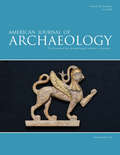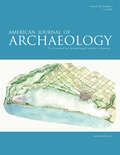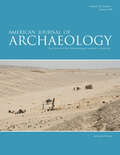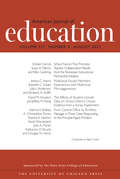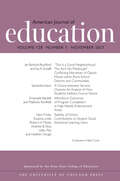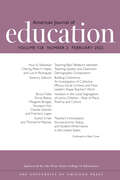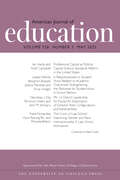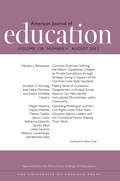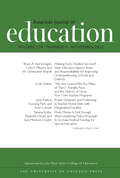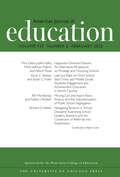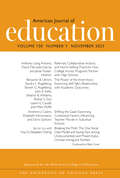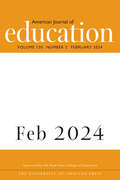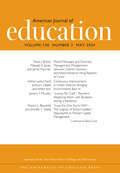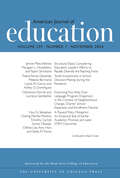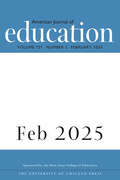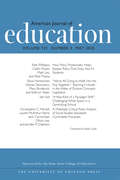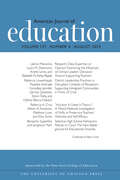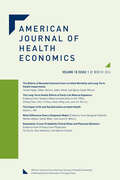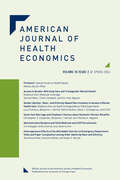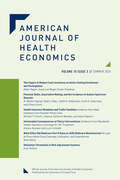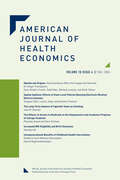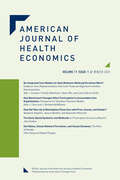- Table View
- List View
American Journal of Archaeology, volume 129 number 2 (April 2025)
by American Journal of ArchaeologyThis is volume 129 issue 2 of American Journal of Archaeology. The American Journal of Archaeology, the journal of the Archaeological Institute of America, was founded in 1885 and is one of the world's most distinguished and widely distributed peer-reviewed archaeological journals. The AJA reaches more than 40 countries and approximately 700 universities, learned societies, departments of antiquities, and museums. The AJA publishes original research on the diverse peoples and material cultures of the Mediterranean and related areas, including North Africa (with Egypt and Sudan), Western Asia (with the Caucasus), and Europe, from prehistory through late antiquity.
American Journal of Archaeology, volume 129 number 3 (July 2025)
by American Journal of ArchaeologyThis is volume 129 issue 3 of American Journal of Archaeology. The American Journal of Archaeology, the journal of the Archaeological Institute of America, was founded in 1885 and is one of the world's most distinguished and widely distributed peer-reviewed archaeological journals. The AJA reaches more than 40 countries and approximately 700 universities, learned societies, departments of antiquities, and museums. The AJA publishes original research on the diverse peoples and material cultures of the Mediterranean and related areas, including North Africa (with Egypt and Sudan), Western Asia (with the Caucasus), and Europe, from prehistory through late antiquity.
American Journal of Archaeology, volume 129 number 4 (October 2025)
by American Journal of ArchaeologyThis is volume 129 issue 4 of American Journal of Archaeology. The American Journal of Archaeology, the journal of the Archaeological Institute of America, was founded in 1885 and is one of the world's most distinguished and widely distributed peer-reviewed archaeological journals. The AJA reaches more than 40 countries and approximately 700 universities, learned societies, departments of antiquities, and museums. The AJA publishes original research on the diverse peoples and material cultures of the Mediterranean and related areas, including North Africa (with Egypt and Sudan), Western Asia (with the Caucasus), and Europe, from prehistory through late antiquity.
American Journal of Education, volume 127 number 4 (August 2021)
by American Journal of EducationThis is volume 127 issue 4 of American Journal of Education. The American Journal of Education seeks to bridge and integrate the intellectual, methodological, and substantive diversity of educational scholarship and to encourage a vigorous dialogue between educational scholars and policy makers. It publishes empirical research, from a wide range of traditions, that contributes to the development of knowledge across the broad field of education.
American Journal of Education, volume 128 number 1 (November 2021)
by American Journal of EducationThis is volume 128 issue 1 of American Journal of Education. The American Journal of Education seeks to bridge and integrate the intellectual, methodological, and substantive diversity of educational scholarship and to encourage a vigorous dialogue between educational scholars and policy makers. It publishes empirical research, from a wide range of traditions, that contributes to the development of knowledge across the broad field of education.
American Journal of Education, volume 128 number 2 (February 2022)
by American Journal of EducationThis is volume 128 issue 2 of American Journal of Education. The American Journal of Education seeks to bridge and integrate the intellectual, methodological, and substantive diversity of educational scholarship and to encourage a vigorous dialogue between educational scholars and policy makers. It publishes empirical research, from a wide range of traditions, that contributes to the development of knowledge across the broad field of education.
American Journal of Education, volume 128 number 3 (May 2022)
by American Journal of EducationThis is volume 128 issue 3 of American Journal of Education. The American Journal of Education seeks to bridge and integrate the intellectual, methodological, and substantive diversity of educational scholarship and to encourage a vigorous dialogue between educational scholars and policy makers. It publishes empirical research, from a wide range of traditions, that contributes to the development of knowledge across the broad field of education.
American Journal of Education, volume 128 number 4 (August 2022)
by American Journal of EducationThis is volume 128 issue 4 of American Journal of Education. The American Journal of Education seeks to bridge and integrate the intellectual, methodological, and substantive diversity of educational scholarship and to encourage a vigorous dialogue between educational scholars and policy makers. It publishes empirical research, from a wide range of traditions, that contributes to the development of knowledge across the broad field of education.
American Journal of Education, volume 129 number 1 (November 2022)
by American Journal of EducationThis is volume 129 issue 1 of American Journal of Education. The American Journal of Education seeks to bridge and integrate the intellectual, methodological, and substantive diversity of educational scholarship and to encourage a vigorous dialogue between educational scholars and policy makers. It publishes empirical research, from a wide range of traditions, that contributes to the development of knowledge across the broad field of education.
American Journal of Education, volume 129 number 2 (February 2023)
by American Journal of EducationThis is volume 129 issue 2 of American Journal of Education. The American Journal of Education seeks to bridge and integrate the intellectual, methodological, and substantive diversity of educational scholarship and to encourage a vigorous dialogue between educational scholars and policy makers. It publishes empirical research, from a wide range of traditions, that contributes to the development of knowledge across the broad field of education.
American Journal of Education, volume 129 number 3 (May 2023)
by American Journal of EducationThis is volume 129 issue 3 of American Journal of Education. The American Journal of Education seeks to bridge and integrate the intellectual, methodological, and substantive diversity of educational scholarship and to encourage a vigorous dialogue between educational scholars and policy makers. It publishes empirical research, from a wide range of traditions, that contributes to the development of knowledge across the broad field of education.
American Journal of Education, volume 129 number 4 (August 2023)
by American Journal of EducationThis is volume 129 issue 4 of American Journal of Education. The American Journal of Education seeks to bridge and integrate the intellectual, methodological, and substantive diversity of educational scholarship and to encourage a vigorous dialogue between educational scholars and policy makers. It publishes empirical research, from a wide range of traditions, that contributes to the development of knowledge across the broad field of education.
American Journal of Education, volume 130 number 1 (November 2023)
by American Journal of EducationThis is volume 130 issue 1 of American Journal of Education. The American Journal of Education seeks to bridge and integrate the intellectual, methodological, and substantive diversity of educational scholarship and to encourage a vigorous dialogue between educational scholars and policy makers. It publishes empirical research, from a wide range of traditions, that contributes to the development of knowledge across the broad field of education.
American Journal of Education, volume 130 number 2 (February 2024)
by American Journal of EducationThis is volume 130 issue 2 of American Journal of Education. The American Journal of Education seeks to bridge and integrate the intellectual, methodological, and substantive diversity of educational scholarship and to encourage a vigorous dialogue between educational scholars and policy makers. It publishes empirical research, from a wide range of traditions, that contributes to the development of knowledge across the broad field of education.
American Journal of Education, volume 130 number 3 (May 2024)
by American Journal of EducationThis is volume 130 issue 3 of American Journal of Education. The American Journal of Education seeks to bridge and integrate the intellectual, methodological, and substantive diversity of educational scholarship and to encourage a vigorous dialogue between educational scholars and policy makers. It publishes empirical research, from a wide range of traditions, that contributes to the development of knowledge across the broad field of education.
American Journal of Education, volume 130 number 4 (August 2024)
by American Journal of EducationThis is volume 130 issue 4 of American Journal of Education. The American Journal of Education seeks to bridge and integrate the intellectual, methodological, and substantive diversity of educational scholarship and to encourage a vigorous dialogue between educational scholars and policy makers. It publishes empirical research, from a wide range of traditions, that contributes to the development of knowledge across the broad field of education.
American Journal of Education, volume 131 number 1 (November 2024)
by American Journal of EducationThis is volume 131 issue 1 of American Journal of Education. The American Journal of Education seeks to bridge and integrate the intellectual, methodological, and substantive diversity of educational scholarship and to encourage a vigorous dialogue between educational scholars and policy makers. It publishes empirical research, from a wide range of traditions, that contributes to the development of knowledge across the broad field of education.
American Journal of Education, volume 131 number 2 (February 2025)
by American Journal of EducationThis is volume 131 issue 2 of American Journal of Education. The American Journal of Education seeks to bridge and integrate the intellectual, methodological, and substantive diversity of educational scholarship and to encourage a vigorous dialogue between educational scholars and policy makers. It publishes empirical research, from a wide range of traditions, that contributes to the development of knowledge across the broad field of education.
American Journal of Education, volume 131 number 3 (May 2025)
by American Journal of EducationThis is volume 131 issue 3 of American Journal of Education. The American Journal of Education seeks to bridge and integrate the intellectual, methodological, and substantive diversity of educational scholarship and to encourage a vigorous dialogue between educational scholars and policy makers. It publishes empirical research, from a wide range of traditions, that contributes to the development of knowledge across the broad field of education.
American Journal of Education, volume 131 number 4 (August 2025)
by American Journal of EducationThis is volume 131 issue 4 of American Journal of Education. The American Journal of Education seeks to bridge and integrate the intellectual, methodological, and substantive diversity of educational scholarship and to encourage a vigorous dialogue between educational scholars and policy makers. It publishes empirical research, from a wide range of traditions, that contributes to the development of knowledge across the broad field of education.
American Journal of Health Economics, volume 10 number 1 (Winter 2024)
by American Journal of Health EconomicsThis is volume 10 issue 1 of American Journal of Health Economics. The American Journal of Health Economics (AJHE) provides a forum for the in-depth analysis of health care markets and individual health behaviors. The articles appearing in AJHE are authored by scholars from universities, private research organizations, government, and industry. Subjects of interest include competition among private insurers, hospitals, and physicians; impacts of public insurance programs; pharmaceutical innovation and regulation; medical device supply; the rise of obesity and its consequences; the influence and growth of aging populations; and much more. The journal is published for the American Society of Health Economists (ASHEcon), which is a professional, non-profit organization dedicated to promoting excellence in health economics research in the United States.
American Journal of Health Economics, volume 10 number 2 (Spring 2024)
by American Journal of Health EconomicsThis is volume 10 issue 2 of American Journal of Health Economics. The American Journal of Health Economics (AJHE) provides a forum for the in-depth analysis of health care markets and individual health behaviors. The articles appearing in AJHE are authored by scholars from universities, private research organizations, government, and industry. Subjects of interest include competition among private insurers, hospitals, and physicians; impacts of public insurance programs; pharmaceutical innovation and regulation; medical device supply; the rise of obesity and its consequences; the influence and growth of aging populations; and much more. The journal is published for the American Society of Health Economists (ASHEcon), which is a professional, non-profit organization dedicated to promoting excellence in health economics research in the United States.
American Journal of Health Economics, volume 10 number 3 (Summer 2024)
by American Journal of Health EconomicsThis is volume 10 issue 3 of American Journal of Health Economics. The American Journal of Health Economics (AJHE) provides a forum for the in-depth analysis of health care markets and individual health behaviors. The articles appearing in AJHE are authored by scholars from universities, private research organizations, government, and industry. Subjects of interest include competition among private insurers, hospitals, and physicians; impacts of public insurance programs; pharmaceutical innovation and regulation; medical device supply; the rise of obesity and its consequences; the influence and growth of aging populations; and much more. The journal is published for the American Society of Health Economists (ASHEcon), which is a professional, non-profit organization dedicated to promoting excellence in health economics research in the United States.
American Journal of Health Economics, volume 10 number 4 (Fall 2024)
by American Journal of Health EconomicsThis is volume 10 issue 4 of American Journal of Health Economics. The American Journal of Health Economics (AJHE) provides a forum for the in-depth analysis of health care markets and individual health behaviors. The articles appearing in AJHE are authored by scholars from universities, private research organizations, government, and industry. Subjects of interest include competition among private insurers, hospitals, and physicians; impacts of public insurance programs; pharmaceutical innovation and regulation; medical device supply; the rise of obesity and its consequences; the influence and growth of aging populations; and much more. The journal is published for the American Society of Health Economists (ASHEcon), which is a professional, non-profit organization dedicated to promoting excellence in health economics research in the United States.
American Journal of Health Economics, volume 11 number 1 (Winter 2025)
by American Journal of Health EconomicsThis is volume 11 issue 1 of American Journal of Health Economics. The American Journal of Health Economics (AJHE) provides a forum for the in-depth analysis of health care markets and individual health behaviors. The articles appearing in AJHE are authored by scholars from universities, private research organizations, government, and industry. Subjects of interest include competition among private insurers, hospitals, and physicians; impacts of public insurance programs; pharmaceutical innovation and regulation; medical device supply; the rise of obesity and its consequences; the influence and growth of aging populations; and much more. The journal is published for the American Society of Health Economists (ASHEcon), which is a professional, non-profit organization dedicated to promoting excellence in health economics research in the United States.
